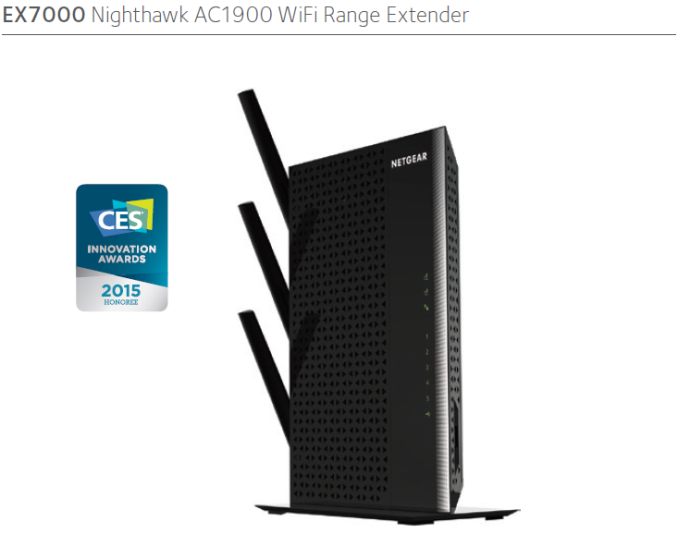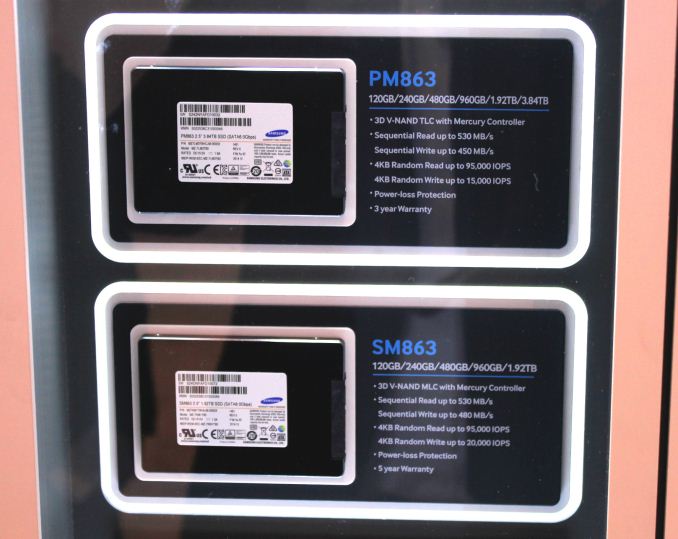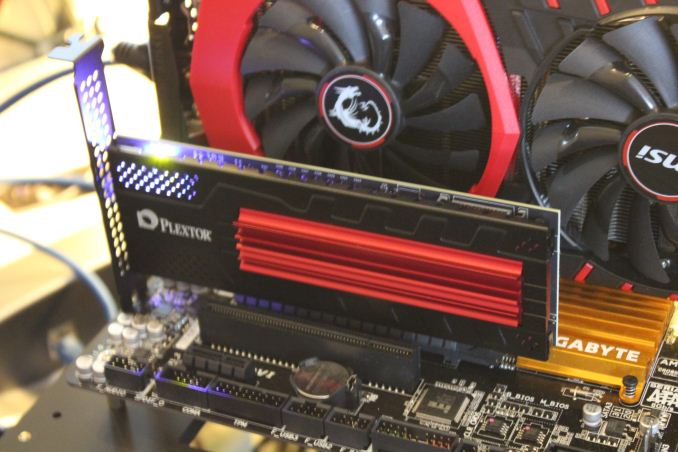
ECS LIVA X Review: A Fanless Bay Trail-M mini-PC
Over the last couple of years, mini-PCs in the ultra-compact form factor (UCFF) have emerged as one of the bright spots in the troubled PC market. ECS first took on this market with the help of the LIVA mini-PC. They have iterated fast to resolve some of the shortcomings of the original LIVA in their latest mini-PC, the LIVA X. Read on for our review of the latest passively cooled mini-PC offering from ECS.
Read More ...
Intel Reports Record Q4 And Full Year Revenue
Intel released their Q4 FY 2014 results today, and they capped a record year with another record quarter. Revenue for Q4 came in at $14.7 billion, up 6% year-over-year, and for the full fiscal year 2014 revenues were a record $55.9 billion, also up 6%. Gross Margin for the quarter was 65.4%, up 3.4% over the same quarter last year, and Q4 net income was $3.7 billion, up 39% over Q4 2013. Net income for the fiscal year was $11.7 billion, up 22% over 2013. Earnings per share for the most recent quarter came in at $0.74, beating analyst’s expectations of $0.66 per share.
With numbers such as those, one would think Intel is on top of its game, and in the PC market it certainly is. Mobile is a different story for Intel, where it has struggled to gain traction compared to competitors using ARM’s ISA. Intel announced a contra revenue plan in November 2013, where it would subsidize the cost difference and help manufacturers implement Intel based mobile devices rather than ARM. It certainly has been successful, with Intel at the heart of many devices launched last year, including such low cost devices as the HP Stream 7. The plan has been so successful that it has cost Intel an additional $1.1 billion in operating income in Q4 alone, which brings the FY 2014 total to $4.2 billion in loss from this one division, up from the $3.1 billion loss in 2013. Clearly Intel has work to do in order to become cost competitive in this space, and they are likely hedging their bets on their 14 nm process which has just come on-line and the next generation Cherry Trail Atom core.
Looking at the individual groups, the PC Client Group had revenue of $8.9 billion, which was up 3% over the previous year. Volume was up 6%, but average selling price (ASP) was down 2%. Desktop platform volumes were down 1% with a flat ASP, and notebook platform volumes were up 11% with ASP down 3%. As compared to last quarter, revenue was down 3%, platform volumes were down 5%, and ASP was up 3%. While industry analysts IDC and Gartner debate whether the PC slowdown has slowed or rebounded, Intel’s numbers seem to indicate that 2014 was a much better year than was originally projected for the PC market.
The Data Center Group had revenue of $4.1 billion for Q4, which is up 25% year-over-year. Platform volumes were up 15% and ASP was up 10% year-over-year. Quarter-over-quarter, revenue was up 11% and volumes were up 5%, with ASP up 7%. The Data Center Group has been very strong this year, and now accounts for almost 30% of Intel’s revenue. The Xeon line is very strong right now, especially when data centers are often power constrained. Competition from ARM based alternatives is in the early stages, but it will be a tough market to penetrate at the moment.
Internet of Things was all the rage at CES this year, and Intel’s IoT group had revenue of $591 million, up 10% as compared to last year, and up 12% from the previous quarter.
The previously mentioned Mobile and Communications group actually had negative revenue for the quarter, coming in at negative $6 million, which is down from $1 million in revenue last quarter.
Software and services had revenue of $557 million, down 6% year-over-year and flat as compared to Q3.
The “other” group had revenue of $617 million, up 23% over Q4 2013, and up 7% over last quarter.
| Intel Q4 2014 Financial Results (GAAP) | |||||
| Q4'2014 | Q3'2014 | Q4'2013 | |||
| Revenue | $14.721B | $14.554B | $13.834B | ||
| Operating Income | $4.453B | $4.918B | $3.549B | ||
| Net Income | $3.661B | $3.317B | $2.625B | ||
| Gross Margin | 65.4% | 65.0% | 62.0% | ||
| PC Group Revenue | $8.871B | -3% | +3% | ||
| Data Center Group Revenue | $4.091B | +11% | +25% | ||
| Internet of Things Revenue | $591M | +12% | +10% | ||
| Mobile Group Revenue | -$6M | -700% | -102% | ||
| Software and Services Revenue | $557M | 0% | -6% | ||
| All Other Revenue | $617M | +7% | +23% | ||
The big story for Q4 was the availability of the first 14 nm parts, with Core-M devices being launched later in the quarter. The Core-M parts are the very low power offerings though (around 5 watts) and the U series 15-28 watt parts just launched at CES last week. 22 nm was alive for a bit longer than Intel would have hoped, and hopefully the 14 nm delays do not impact the next generation Skylake CPUs.
Outlook for Q1 2015 is revenue of $13.7 billion, plus or minus $500 million, which is down 7% from Q4 2014. Intel says this is normal due to the average seasonal decrease for the first quarter. Gross margin for Q1 is pegged at 60%, which is down 5.4% from Q4, and this is due to higher platform costs for 14 nm products, lower volumes, factory start-up costs, and Skylake pre-qualification costs. Intel is projecting revenue for 2015 to grow in the mid-single digits, and an overall gross margin of 62%.
2014 was a fantastic year for Intel, with record revenues overall. The mobile sector is still a sore spot, and there have already been some changes there with mobile being moved into the PC unit. Many people expected that to be done to mask the losses, but Intel did report it as a separate group for Q4, although that may change in the future. More Core like processors in mobile may be exactly what Intel needs, with higher IPC and the ability to run at a lower clock speed due to good IPC.
Source: Intel Investor Relations
Read More ...
Wearables: 2014 and Beyond
As the year 2014 has come to a close, now is a good time to inventory changes in the consumer electronics market and project those trends forward. One of the most obvious changes was that wearable technology has, by my observation, approached the brink of the adoption chasm into the early majority. In this article we will focus on the significant business and consumer factors of wearable technology, the notable introductions in 2014, as well as future AnandTech coverage.
Read More ...
Netgear Launches ARM Cortex-A15-based ReadyNAS 200 Series
Netgear's major announcement at CES 2015 was the ReadyNAS 200 series of NAS units targeting the SOHO market and power users. This lineup has two members, a 2-bay RN202 and a 4-bay RN204. The ReadyNAS 200 series is based on a dual-core Cortex-A15 SoC from Annapurna Labs. The system has 2 GB of RAM and two GbE ports. 802.3ad dynamic link aggregation is supported, and transfer rates of around 200 MBps are possible (similar to what QNAP claims for their TS-x31+ series). The units run ReadyNAS OS 6.2 and have a MSRP of $360 and $500 for the 2-bay and 4-bay variants.
As I mentioned in our COTS NAS buyer's guide last month, Netgear's ReadyNAS OS 6.x is quite interesting because of the choice of a btrfs file system. We also get snapshots with minimal overhead (due to the COW - Copy on Write - nature of the file system) and protection against bit-rot. The ReadyNAS 200 series provides a powerful, yet affordable alternative to the ReadyNAS 300 and ReadyNAS 500 series of NAS units.
At the show, Netgear also launched the AirCard, a battery-powered 4G hotspot device connecting to the Sprint network. The $200 price also includes 1 GB of data, with the option to purchase more further down the road. In the ProSAFE lineup, we also got Click Switches - 8- and 16- port GbE unmanaged switches with USB charging ports. The focus of the product is on ease of use and versatility. On the powerline networking front, Netgear had their HomePlug AV2 PL1200 and PLP1200 devices on display.
Netgear decided to hold off on any major router announcements at CES. Most of the other networking vendors announcing flagship products were planning to ship in Q2 or later. This obviously points to the hardware platforms not being ready. It does make plenty of sense for Netgear to announce products closer to their release dates. In addition, they got in first on the Broadcom XStream platform with the Nighthawk X6 R8000 and second on the 4x4 MU-MIMO Quantenna solution (after Asus) with the Nighthawk X4 R7500. They have both flagships currently in the market. The focus at CES was more on the software updates (such as ReadyCLOUD integration, configurable power output for the Wi-Fi radios etc.) that Negear had in the pipeline for the R7000 platform.
That said, they did show off a Nighthawk AC1900 range extender - basically, the same internal hardware as the R7000, but, without routing support, and priced a good $30 cheaper.
Read More ...
More DDR4-3400: G.Skill’s 4x4GB CL 16 Kit Released
When we look at the history of DDR3, a number of key advertising points were consistent across most of the memory manufacturers. First was high speed in terms of out of the box, and the other was high speed from overclocking. The big names all went for these records, and after we posted about Corsair’s DDR4-3400 kit a couple of days ago, G.Skill is also jumping onto the bandwagon. However, the kit is very slightly different – G.Skill is supporting 16-16-16-36 timings, compared to Corsair’s 16-18-18-40. Whether that means much in real-world usage is hard to say, but I would imagine G.Skill, given the history between the two, will also compete on price. So perhaps under $1000, which would be a big hit in anyone's build.
This 4x4 GB kit will also be flanked by a new DDR4-3200 4x4 GB kit, available at 15-15-15-35 timings, which also undercuts the competition. Both of the new kits from G.Skill are validated on the GIGABYTE X99-SOC Champion and the ASUS Rampage V Extreme.
The kits will also come with G.Skill’s Turbulence III fans to provide extra cooling. There is no date currently mentioned by G.Skill, but 'released' often means 'heading to distributors'. Given the high specifications of the kit, I would imagine only a handful are actually going on sale.
We still have a round-up of DDR4 memory kits planned in the works, from 2133 to 3200 (perhaps 3400 if we can get them), so stay tuned for that.
Source: G.Skill
Read More ...
Samsung Displays New 3D V-NAND Based Enterprise SSDs at CES 2015
Along with the release of the SM951 PCIe SSD, Samsung had several new enterprise SSDs on display at the show. The PM863 and SM863 are SATA 6Gbps drives and pack a new Mercury controller (unfortunately I don't have any specifics at this point), but what's intriguing is the available capacities. The PM863 with 32-layer 128Gbit TLC NAND comes in up to 3.84TB capacity in 2.5" form factor, whereas the SM863 with 32-layer 86Gbit MLC NAND offers a half of that (i.e. 1.92TB). Sustained 4KB random write performance is a decent 15K IOPS for the PM863 and 20K for the SM863, but there is no word about endurance at this point.
In addition to SATA drives, Samsung showed off three new SAS drives with new REX controller and 3D V-NAND. Capacities are once again impressive with the PM1633 packing up to 3.84TB in 2.5" and thanks to the SAS 12Gbps interface sequential performance is doubled compared to the SATA 6Gbps drives.
And lastly, Samsung also displayed the enterprise version of the SM951 i.e. the SM953. The change compared to the SM951 is M.2 22110 form factor to fit the capacitor on the PCB for power-loss protection, but otherwise the SM953 shares the same core hardware. The firmware is obviously enterprise-oriented with focus on sustained figures, hence the slightly lower performance specs.
Read More ...
Plextor Releases M6e Black Edition PCIe SSD, Shows Off Upcoming M7e PCIe SSD & TLC SSD
Continuing with our CES SSD coverage, Plextor released a new M6e Black Edition PCIe SSD at the show. Unfortunately, the Black Edition offers nothing new in terms of the hardware or firmware design and it's merely a normal M6e with fancy black 'n red heat sinks. The controller is the same Marvell 88SS9183, which is a PCIe 2.0 x2 design without NVMe support, and the controller is coupled with Toshiba's 19nm MLC NAND. Performance is rated at 770MB/s sequential read and 625MB/s sequential write with up to 105K random read and 100K random write IOPS, similar to the original M6e. I can see the reasoning behind the Black Edition since the M6e was a very plain green PCB design and especially gamers with side window cases will appreciate the new design, but otherwise the Black Edition doesn't bring anything new to the market.
The drive will be available later in Q1'15 and will be sold exclusively through NewEgg. Pricing is about $1 per gigabyte for the 128GB model and the larger capacities will be somewhat more cost efficient (exact pricing is to be announced). We never got around to review the original M6e due to some testbed issues, but I now have a new testbed and all capacities of the M6e Black Edition, so stay tuned for the full review (you may even get a sneak peek of our new 2015 Client SSD Suite).
Along with the M6e Black Edition, Plextor is also releasing a 2.0 version of PlexTurbo. The software is similar to Samsung's RAPID in the sense that it uses system RAM to cache IOs and boost performance. The 2.0 version brings increased RAM allocation (25% or up to 4GB) in addition to better optimized caching algorithm that provides even higher performance. I'll also be taking a look at the PlextTurbo software in the upcoming M6e Black Edition review.
Moving on to upcoming releases, Plextor also demonstrated the successor of the M6e i.e. the M7e. The biggest change is the new controller (Marvell 88SS9283), which doubles the amount of PCIe lanes to four, but it's still a PCIe 2.0 design that relies on AHCI (i.e. no NVMe).
Performance wise the M7e presents nearly 100% improvement, at least in sequential speeds. The drive is still in development, so there aren't any finalized specifications yet, but the drive should be available in H1'15.
Lite-on, Plextor's parent company, had the enterprise version of the M7e called the EP1 in the suite. The controller is the same Marvell 88SS9283, but the drive has capacitors for power-loss protection and the firmware has also been optimized for enterprise workloads (i.e. more emphasis on consistency rather than peak performance). 480GB and 960GB capacity options are available in M.2 22110 form factor with performance being up to 1.5GB/s read and 1.2GB/s write.
Plextor/Lite-on has been developing a TLC NAND based SSD for quite some time now and the release is nearing every day. Dubbed as the M6V, the drive will utilize Marvell's new 88SS1074 controller with LDPC error correction for increased endurance.
The NAND will be Toshiba's A19nm TLC. The schedule is still a bit open from what I heard, but the drive should make an entry to the market around mid-2015 timeframe.
Read More ...
Apple Offers Refurbished 5K Retina iMacs for $2,119 Online
If you want a high resolution OS X or Windows machine, this is a pretty attractive offer
Read More ...
Microsoft Trolls Jan. Xbox One Buyers, Drops Price Back to $349
January buyers are left feeling a bit robbed after Microsoft reveals price rebound was just a one-and-a-half-week sort of deal
Read More ...
Great Expectations: The Rise and Fall of Google Glass Explorer Edition
High price, privacy issues, poor public image doomed the device, although it could be revamped eventually and make a combeback
Read More ...
Crowdfunded Sex Toy Lets You Control the Action From Your Wii Nunchuk
Dildo's code is hackable, thanks to easy to modify Arduino microcontroller inside
Read More ...
BlackBerry Laughs Off Rumor That Samsung is Eyeing to Buy it for $6.5-7.5 Billion
BlackBerry management reportedly have rejected several bids, want to finish growing the company first
Read More ...
Nintendo Preps "New" 3DS XL for EU, U.S. Launch, Teases at Fire Emblem, Zelda
The New Nintendo 3DS XL gets sweet exclusive editions, coveted titles, just in time for a Feb. EU and U.S. (NA) launch
Read More ...
Available Tags:Intel , Samsung , 3D , SSD , SSD , Apple , Microsoft , Xbox , Google , BlackBerry , Nintendo ,






















No comments:
Post a Comment